G
Guest
WELCOME ALL TAG RACERS...
This is your cyberstation location for emanation to another destination in Aerospace.
Crews will be assembling shortly for take off, please ready your rigs and bolt down your aerators...its hopefully NOT going to be a bumpy ride.
But those that know anything about TAGing know...its aint no cake walk.
So, what is TAG? You ask. And what is pod racing?
Well, these are the
Basics for TAG:
1. PSI > 30, 50=Ideal, 100 psi even better.
2. Interval cycling 20-30 seconds on, 3-4 minutes off (Dark periods may extend dry periods).
3.Average droplet size 50µ (micron) nozzles (acceptable ranges 30-80µ) with flows < 2 gph preferably .5-1gph with screen filters of 150 and up.
4.Target root temperatures maintained at 68F. (Mature clones lower temps/younger prefer warmer) Temperatures should never exceed 74F (Dangerous).
5. The greater the aerospace around the root zones the better—lateral root development equals bud thickness and development your goal are pom pom roots.
6. Nutrient strengths for TAG are extremely ratio sensitive. Most strains will demonstrate deficiencies in K, Ca, Mg, and P, for optimal absorption of nutrients ratios shoud be as follows:
Ca:Mg 3:1
NO3:NH4 9:1
ph is 5.4-5.8
7. Always have a back up pump or system for failure—always!
8. Root zones should be completely dark and sealed from any UV penetration. UV kills AM (bacteria that feeds the root system)
9.Always use RO water and premix nutrients before adding to systems to prevent chemicals from coming out of solution and clogging nozzles as well as 150 mesh filter or higher.
Now a more indepth if you like...
Compendium for TAG (True Aero Growing)
The principles of aeroponics differ considerably from other methods of plant propagation. Several factors influence the rapid absorption and accelerated grow that can be expected when rig designs are brought closer to the True Aero Environment. TAE
These factors establish a the optimal TAE.
This environment consists of these requirements:
Ideal rooting environments should be unrestricted with enough volume to allow every square cm of root zone to become completely coated with a micro-fine mist of 50µ average population nutrient solution every 3 to 4 minutes in under 60 seconds (preferably 20-30 second misting cycles).
Root Zone Temperatures are found to be ideally suited at approximately 68-72F for maximum efficiency, though younger plants grow faster at higher temperatures and older ones at lower—these extremes are not conducive to the microculture necessary to support the root colonies and risk of possible bad bacterial infections. The use of HG or any AM inoculant is advised and recommended.
Ideal root temperature has been established at 68F as being TAT. (Target Aero Temperature)
Root zone temperatures should see very little temperature fluctuation and absolutely no light penetration if possible. Anything above 75F should be considered dangerous to the health and well being of your plants and HydroGuard or other benefical is highly recommended. Beneficials are recommended in general as the speed and growth in a TAE is exceptional and the rooting environment needs as much support as possible to keep up with increasing growth demands.
A basic understanding of certain principles are necessary for all TAGers. These concern uptake of nutrition and supplimentation as the rapidly accelerated growth available in TAGing requires accurate and relatively precise balances of major life processes.
Here are some that will help the beginning TAGer understand the importance and value of precision delivery.
The basic principles
of aeroponic delivery are the rapid exchange of gases between the membranes of the root subculture and the plant roots. Application of a micro-fine nutrient film that is readily absorbed and evaporated before the next aerosol cycle is the goal.
The need for 50µ-target size for micro droplets is based on the findings by researchers that the average tube opening on the root hairs is approximate 20-50µ or within a range from 5-100µ.
The specific reason for this importance is as follows:
Aero isn't about DO. There really isn't that much in True aero, as I've mentioned. It has to do with uniformity of droplet size.
The mist that is created by these nozzles is micro fine and all the drops are pretty much the same size and an ideal size for optimum uptake.
You have a hundred different size balls that you are trying to get through a screen with holes that only fit things the size of a ping pong ball or smaller. Your standard mister is going to have like a 50/50 mix of sizes and the bigger ones have to hang out until something comes along to break it into several smaller balls kind of like the game 'asteroids' if you remember it.
True aero is a spray of balls that are all the size of ping pong balls or smaller, so everything goes right through the screen without having to wait to be broken up into smaller pieces.
That is what is happening on a microscopic level at your root level. The need for O2 is that it breaks down those H20 molecules and helps tear apart CO2 the O's are all what they call 'Free Radical' Meaning they bond with anything immediately. It is called Oxidation. That is why your blood is red, oxidized iron in your blood. It is how hemoglobin is created. All cells respire gases...it is smaller than water vapor or even the molecules themselves. O2 is a gas, CO2 is a gas, Nitrogen is a gas, Hydrogen is a gas these are all gases that when combined together to make a 'big ball' make water H20 or CO2 or any of the elements you are feeding your plant.
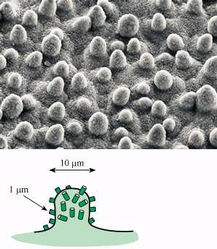
The first picture is a close-up of a lotus leaf, an example of a super-hydrophobic plant. The roughness of the leaf surface results from the coexistence of bumps about 10 µm(10 microns) wide and hollow channels of about 1 µm(micron) in diameter. The entire surface is covered by a layer of wax that makes it hydrophobic. The ability of the leaf to repel water is enhanced by the surface roughness. (Picture credit: W Barthlott)
That said:

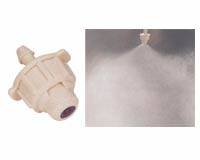
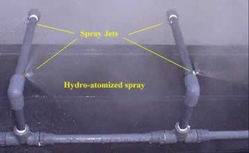
Nozzles are geared towards irrigation and as such utilize a vortex flow, which means that the droplet size does not change with pressure but is indeed from 5 to 200 microns. The majority of the droplet population is about 100 microns, however there is a broad-spectrum of sizes.
PSI/Dan foggers will create 'true' aero fogging at around 50 to 80 microns, but doesn’t have consistent droplet sizes below 50. The best you could do would be a fogger nozzle with populations between 20-50 microns which are the Bio-Control nozzles.
Why Atomize?
Imagine two droplets of the same size, one droplet you break up [atomize] into 1000 smaller droplets and the other you leave alone. If you measure the surface area of each "small droplet" and add them up, the result will be more than the total surface area of single large droplet. Simply put, the smaller the droplet size, the more surface area you'll have at a given flow rate. More surface area translates into more efficient heat transfer, surface contact or reaction within a gas stream.
All mediums get in the way of gas exchange and mediumless growing is preferred.
Spray mist less than 20 microns tend to remain in the air as a fog and are not readily absorbed by the roots. The ideal mist size range for most plant species is 30 - 80 microns. Within this range the mist makes the most contact with the roots.
Inclines are necessary with most tubes to ensure adequate drainage.
One can reasonably expect 45% faster veg times when the TAE is achieved.
Third in importance for maximum efficiency is cycle timing of nutrient delivery, i.e. the on/off cycle.
Optimal industry standards for TAGing are 20-30 seconds of delivery to 180-240 seconds off depending on environment. Most rely on the 30/3 cycle of 30 seconds on 3 minutes off. This appears to be the maximum effective rate lessening in effectiveness as intervals become longer.
15-minute timers are not to be used in TAG as they overly saturate and dry too long for an effective TAE.
Ideal environments for TAG roots are light proof and completely opaque. Heat and light issues at root zones are the number 1 complication with aeroponic rigs designed without adequate space or drainage.
Nutrient Strengths are still under debate at this time. Current conventions suggest that in TAE nutrient uptake exceeds any other form of Faux Aero, DWC or NFT system so high levels of K and Ca/Mg are necessary in the proper ratios.
Minimum levels in liquid ferts should be as follows:
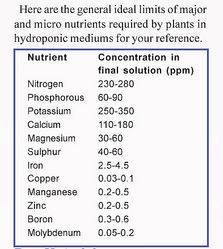
It is to my personal understanding that I believe these numbers could be much higher once nutrient profiles are established for the growth cycle of this plant. There appears to be increased issues with P/K uptake during all phases do to lockout more than over fertilization.
A community of brilliant minds has assembled to race their rigs together to watch for performance enhancement and innovation in design. All are welcomed to join in the fun and learn a little too, maybe.
There will be a number of experts docking at this station, all have exceptional knowledge and experience feel free to question them on their rigs, but be mindful to have read the above before asking any obviously stated questions. And don't hesitate to ask for validation for their design specification, they usually always have a master plan behind it all.
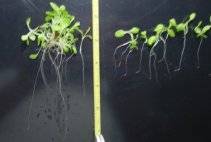
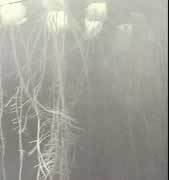

This is your cyberstation location for emanation to another destination in Aerospace.
Crews will be assembling shortly for take off, please ready your rigs and bolt down your aerators...its hopefully NOT going to be a bumpy ride.
But those that know anything about TAGing know...its aint no cake walk.
So, what is TAG? You ask. And what is pod racing?
Well, these are the
Basics for TAG:
1. PSI > 30, 50=Ideal, 100 psi even better.
2. Interval cycling 20-30 seconds on, 3-4 minutes off (Dark periods may extend dry periods).
3.Average droplet size 50µ (micron) nozzles (acceptable ranges 30-80µ) with flows < 2 gph preferably .5-1gph with screen filters of 150 and up.
4.Target root temperatures maintained at 68F. (Mature clones lower temps/younger prefer warmer) Temperatures should never exceed 74F (Dangerous).
5. The greater the aerospace around the root zones the better—lateral root development equals bud thickness and development your goal are pom pom roots.
6. Nutrient strengths for TAG are extremely ratio sensitive. Most strains will demonstrate deficiencies in K, Ca, Mg, and P, for optimal absorption of nutrients ratios shoud be as follows:
Ca:Mg 3:1
NO3:NH4 9:1
ph is 5.4-5.8
7. Always have a back up pump or system for failure—always!
8. Root zones should be completely dark and sealed from any UV penetration. UV kills AM (bacteria that feeds the root system)
9.Always use RO water and premix nutrients before adding to systems to prevent chemicals from coming out of solution and clogging nozzles as well as 150 mesh filter or higher.
Now a more indepth if you like...
Compendium for TAG (True Aero Growing)
The principles of aeroponics differ considerably from other methods of plant propagation. Several factors influence the rapid absorption and accelerated grow that can be expected when rig designs are brought closer to the True Aero Environment. TAE
These factors establish a the optimal TAE.
This environment consists of these requirements:
Ideal rooting environments should be unrestricted with enough volume to allow every square cm of root zone to become completely coated with a micro-fine mist of 50µ average population nutrient solution every 3 to 4 minutes in under 60 seconds (preferably 20-30 second misting cycles).
Root Zone Temperatures are found to be ideally suited at approximately 68-72F for maximum efficiency, though younger plants grow faster at higher temperatures and older ones at lower—these extremes are not conducive to the microculture necessary to support the root colonies and risk of possible bad bacterial infections. The use of HG or any AM inoculant is advised and recommended.
Ideal root temperature has been established at 68F as being TAT. (Target Aero Temperature)
Root zone temperatures should see very little temperature fluctuation and absolutely no light penetration if possible. Anything above 75F should be considered dangerous to the health and well being of your plants and HydroGuard or other benefical is highly recommended. Beneficials are recommended in general as the speed and growth in a TAE is exceptional and the rooting environment needs as much support as possible to keep up with increasing growth demands.
A basic understanding of certain principles are necessary for all TAGers. These concern uptake of nutrition and supplimentation as the rapidly accelerated growth available in TAGing requires accurate and relatively precise balances of major life processes.
Here are some that will help the beginning TAGer understand the importance and value of precision delivery.
The basic principles
of aeroponic delivery are the rapid exchange of gases between the membranes of the root subculture and the plant roots. Application of a micro-fine nutrient film that is readily absorbed and evaporated before the next aerosol cycle is the goal.
The need for 50µ-target size for micro droplets is based on the findings by researchers that the average tube opening on the root hairs is approximate 20-50µ or within a range from 5-100µ.
The specific reason for this importance is as follows:
Aero isn't about DO. There really isn't that much in True aero, as I've mentioned. It has to do with uniformity of droplet size.
The mist that is created by these nozzles is micro fine and all the drops are pretty much the same size and an ideal size for optimum uptake.
You have a hundred different size balls that you are trying to get through a screen with holes that only fit things the size of a ping pong ball or smaller. Your standard mister is going to have like a 50/50 mix of sizes and the bigger ones have to hang out until something comes along to break it into several smaller balls kind of like the game 'asteroids' if you remember it.
True aero is a spray of balls that are all the size of ping pong balls or smaller, so everything goes right through the screen without having to wait to be broken up into smaller pieces.
That is what is happening on a microscopic level at your root level. The need for O2 is that it breaks down those H20 molecules and helps tear apart CO2 the O's are all what they call 'Free Radical' Meaning they bond with anything immediately. It is called Oxidation. That is why your blood is red, oxidized iron in your blood. It is how hemoglobin is created. All cells respire gases...it is smaller than water vapor or even the molecules themselves. O2 is a gas, CO2 is a gas, Nitrogen is a gas, Hydrogen is a gas these are all gases that when combined together to make a 'big ball' make water H20 or CO2 or any of the elements you are feeding your plant.

The first picture is a close-up of a lotus leaf, an example of a super-hydrophobic plant. The roughness of the leaf surface results from the coexistence of bumps about 10 µm(10 microns) wide and hollow channels of about 1 µm(micron) in diameter. The entire surface is covered by a layer of wax that makes it hydrophobic. The ability of the leaf to repel water is enhanced by the surface roughness. (Picture credit: W Barthlott)
That said:



Nozzles are geared towards irrigation and as such utilize a vortex flow, which means that the droplet size does not change with pressure but is indeed from 5 to 200 microns. The majority of the droplet population is about 100 microns, however there is a broad-spectrum of sizes.
PSI/Dan foggers will create 'true' aero fogging at around 50 to 80 microns, but doesn’t have consistent droplet sizes below 50. The best you could do would be a fogger nozzle with populations between 20-50 microns which are the Bio-Control nozzles.
Why Atomize?
Imagine two droplets of the same size, one droplet you break up [atomize] into 1000 smaller droplets and the other you leave alone. If you measure the surface area of each "small droplet" and add them up, the result will be more than the total surface area of single large droplet. Simply put, the smaller the droplet size, the more surface area you'll have at a given flow rate. More surface area translates into more efficient heat transfer, surface contact or reaction within a gas stream.
All mediums get in the way of gas exchange and mediumless growing is preferred.
Spray mist less than 20 microns tend to remain in the air as a fog and are not readily absorbed by the roots. The ideal mist size range for most plant species is 30 - 80 microns. Within this range the mist makes the most contact with the roots.
Inclines are necessary with most tubes to ensure adequate drainage.
One can reasonably expect 45% faster veg times when the TAE is achieved.
Third in importance for maximum efficiency is cycle timing of nutrient delivery, i.e. the on/off cycle.
Optimal industry standards for TAGing are 20-30 seconds of delivery to 180-240 seconds off depending on environment. Most rely on the 30/3 cycle of 30 seconds on 3 minutes off. This appears to be the maximum effective rate lessening in effectiveness as intervals become longer.
15-minute timers are not to be used in TAG as they overly saturate and dry too long for an effective TAE.
Ideal environments for TAG roots are light proof and completely opaque. Heat and light issues at root zones are the number 1 complication with aeroponic rigs designed without adequate space or drainage.
Nutrient Strengths are still under debate at this time. Current conventions suggest that in TAE nutrient uptake exceeds any other form of Faux Aero, DWC or NFT system so high levels of K and Ca/Mg are necessary in the proper ratios.
Minimum levels in liquid ferts should be as follows:

It is to my personal understanding that I believe these numbers could be much higher once nutrient profiles are established for the growth cycle of this plant. There appears to be increased issues with P/K uptake during all phases do to lockout more than over fertilization.
A community of brilliant minds has assembled to race their rigs together to watch for performance enhancement and innovation in design. All are welcomed to join in the fun and learn a little too, maybe.

There will be a number of experts docking at this station, all have exceptional knowledge and experience feel free to question them on their rigs, but be mindful to have read the above before asking any obviously stated questions. And don't hesitate to ask for validation for their design specification, they usually always have a master plan behind it all.


Last edited:


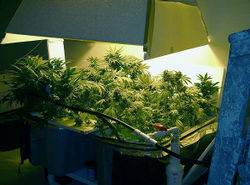
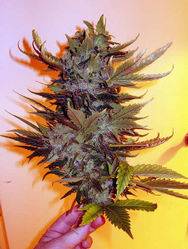
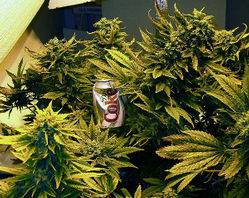
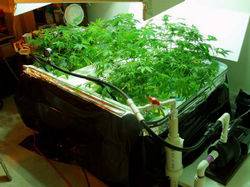




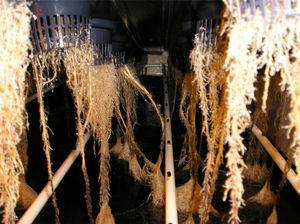
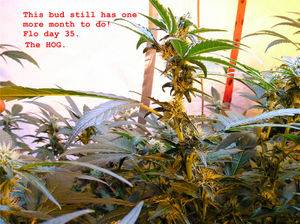
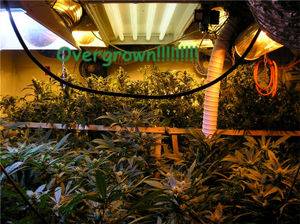

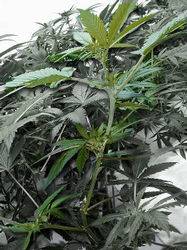
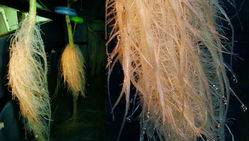





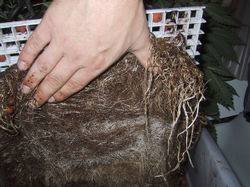
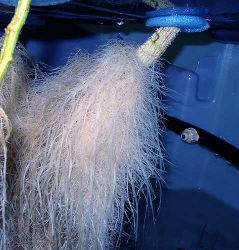
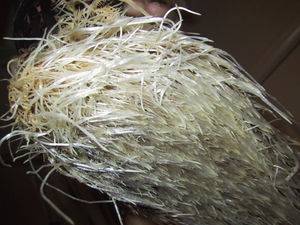
 And I smoke a shitload of weed too, so I'm prone to seeing shit the wrong way. JAT and others will vouch for me, for some reason I'm the one everyone wants to take on and get all shitty when they loose by a mile. I say, don't call me out if you don't want me to throw down, cause I can throw down.
And I smoke a shitload of weed too, so I'm prone to seeing shit the wrong way. JAT and others will vouch for me, for some reason I'm the one everyone wants to take on and get all shitty when they loose by a mile. I say, don't call me out if you don't want me to throw down, cause I can throw down.


